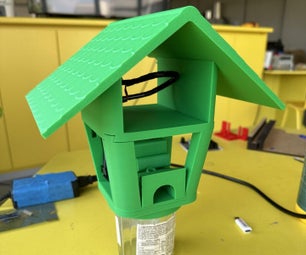Introduction: 555Synth
This project was created during an Instructables Build Night (in collaboration with Jameco) at Open Garage. Using a 555 timer chip, a couple of synths were created, using different capacitor and resistor values. The project uses a variable resistor to change the synth pitch.
Step 1: Build the Basic Circuit
This circuit is heavily inspired by Bare Conductive's 555 Noise Maker circuit.
What you'll need
555 timer chip
9V Battery
9V Battery clip
Breadboard
A variable resistor (eg. conductive rubber, fabric or a potentiometer)
2 Capacitors (2x 1uF will get you started)
1 Resistor (1K Ohm)
1 Piezo speaker
Optional
LED
1 Resistor (220 Ohm)
Wire the circuit using the diagram attached. The LED was added to the circuit to see if the 555 was outputting something. Depending on the values of the capacitors and resistors, the frequency of the pulses the 555 chip generates can be too slow or too fast, resulting in pitches that fall outside of the human hearing range. The LED will visualise the pulses, just to make sure the circuit is working fine.
What you'll need
555 timer chip
9V Battery
9V Battery clip
Breadboard
A variable resistor (eg. conductive rubber, fabric or a potentiometer)
2 Capacitors (2x 1uF will get you started)
1 Resistor (1K Ohm)
1 Piezo speaker
Optional
LED
1 Resistor (220 Ohm)
Wire the circuit using the diagram attached. The LED was added to the circuit to see if the 555 was outputting something. Depending on the values of the capacitors and resistors, the frequency of the pulses the 555 chip generates can be too slow or too fast, resulting in pitches that fall outside of the human hearing range. The LED will visualise the pulses, just to make sure the circuit is working fine.
Step 2: Mod 1 : Conductive Rubber & Textile
A first synth was built using conductive rubber (we used this).
Specific components required:
Capacitors (1x 0.10uF, 1x 100uF)
Conductive rubber
1 Resistor (10K ohm) - depending on the length of the piece of rubber, you might need to add another resistor for a better effect.
Tshirt
Conductive thread
The idea of this synth was that it could be integrated in a tshirt, if you would pull the tshirt down - the pitch of the synth would change. Since the circuit is not too complex, it can be easily transferred to a tshirt using conductive thread (all you need is patience, and by the end of the project - you'll have greatly increased your sewing skills!)
For sewing the components, we used the Open Softwear PDF book, which has some very handy tips when it comes to sewing electronics.
Specific components required:
Capacitors (1x 0.10uF, 1x 100uF)
Conductive rubber
1 Resistor (10K ohm) - depending on the length of the piece of rubber, you might need to add another resistor for a better effect.
Tshirt
Conductive thread
The idea of this synth was that it could be integrated in a tshirt, if you would pull the tshirt down - the pitch of the synth would change. Since the circuit is not too complex, it can be easily transferred to a tshirt using conductive thread (all you need is patience, and by the end of the project - you'll have greatly increased your sewing skills!)
For sewing the components, we used the Open Softwear PDF book, which has some very handy tips when it comes to sewing electronics.
Step 3: Mod2 : Potentiometer & Small Footprint
A second synth uses the same circuit as in the first step, using a potentiometer as an input. Turning the potentiometer increased or decreased the pitch. This synth was created as low piched synth (aka "the bass").
Specific components required:
2 Capacitors 100uF, 200uF
1 Rotary potentiometer (10K Ohm)
(Images of this one will be uploaded soon)
Specific components required:
2 Capacitors 100uF, 200uF
1 Rotary potentiometer (10K Ohm)
(Images of this one will be uploaded soon)










